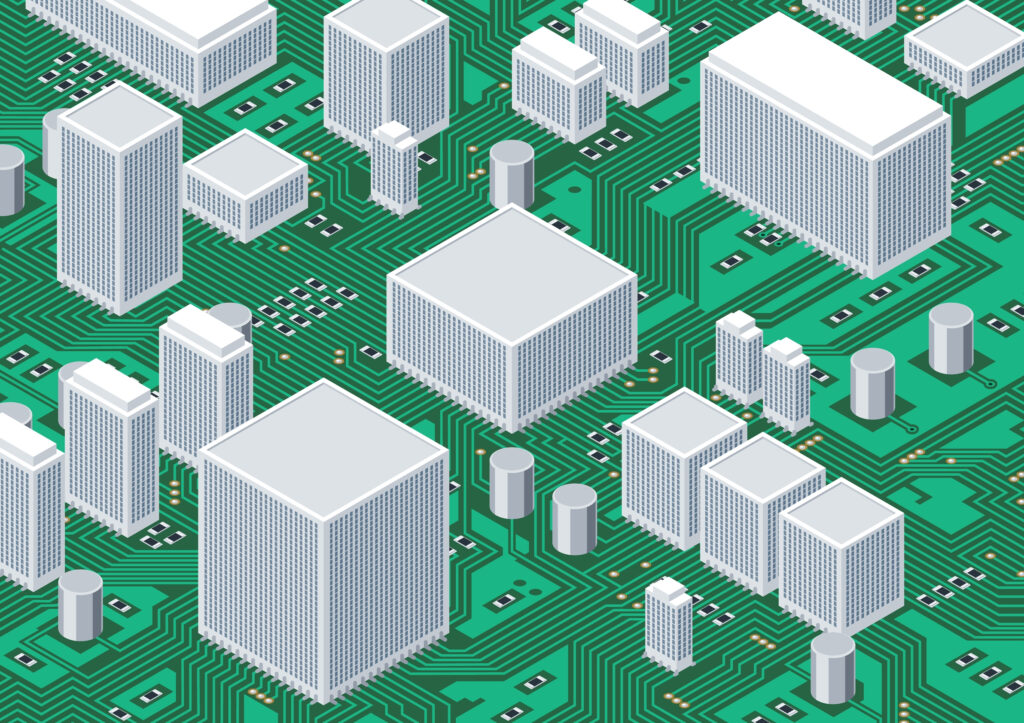“It was not so very long ago that people thought semiconductors were part-time orchestra leaders and that microchips were very small snack foods,” said US politician Geraldine Ferraro in the 1980s about a technology that has gone on to revolutionize the world.
Semiconductors are so essential for the creation of computers, phones, vehicles, and almost all electronic devices, that the growth of the semiconductor industry has become a measure for the development of modern industries and society itself.
As personal computing grew in the 80s and 90s, computer companies signalled their maturity by partnering with semiconductor manufacturers to improve products and their performance. It was the same for the smartphone industry in the 00s and 10s, which quickly became an influential player within the growing semiconductor sector.
Now, in the 2020s it is the turn of smart building and smart city technology providers to demonstrate their “coming of age” through a growing influence within the semiconductor community.
This year, during the Las Vegas’ annual Consumer Electronics Show (CES) on January 11th, building automation stalwart Honeywell announced a new collaboration with NXP Semiconductors. The collaboration aims to help make buildings operate more intelligently by integrating NXP Semiconductors' neural network-enabled, industrial-grade applications processors into Honeywell's core building management systems (BMS).
The memorandum of understanding will initially focus on the Honeywell Optimizer Suite of products, which offer flexible building control and automation. Ultimately, the goal is to fully leverage NXP's i.MX chipset capabilities to further enhance all Honeywell's BMS product offerings with AI/machine learning and data analytics for greater building autonomy, energy efficiency, and maintenance.
"It has never been more important to increase the sustainability and comfort of smart buildings," said Lars Reger, NXP Semiconductors' chief technology officer. "NXP's advanced portfolio combined with Honeywell's expertise as one of the leading building management solution providers, marks an important milestone in our shared vision to enable a smarter, more connected world for all."
Semiconductor companies produce the microchips and processors that provide the brains behind IoT devices and AI applications. NXP's portfolio includes microcontrollers with integrated security features, specifically for safeguarding IoT devices in smart buildings from cyber threats. And, this is just the latest in a steady stream of deals in a smart building space that is becoming a key revenue driver for the Dutch semiconductor firm.

Semiconductor - Smart Building Partnerships
Collaborations and partnerships between semiconductor manufacturers and smart building technology providers are not new but have so far been limited to a narrow set of applications.
As far back as 2014, NXP collaborated with EnOcean to simplify energy harvesting wireless in smart homes. And, since 2015, NXP has partnered with buildings and infrastructure giant Siemens on a variety of specific technologies within the smart buildings, cities, and mobility sectors.
US chip developer NVIDIA has also collaborated with Siemens on industrial applications, as well as partnering with Foxconn on the industrial IoT and smart factories. In September 2022, NVIDIA (through its venture investment arm NVentures) also announced a $15 million investment into building automation company PassiveLogic, further deepening its relationship within smart building technology.
Microchip giant Intel has announced a partnership with building automation major Johnson Controls to drive the performance of its Sensormatic Solutions, which support the use of granular data by users primarily in the retail sector. Intel also partners with Thundersoft, an IoT operating system provider with strong ties to all the major semiconductor companies.
Sony Semiconductor announced a partnership with Microsoft in May 2020 to co-develop AI-powered smart cameras and video analytics. The Japanese firm also partnered with digital reality firm Hexagon to enable real-time digital realities created from sensors to build smart digital twins with high precision.
In Europe, Nordic Semiconductor announced a collaboration with Onomondo in Q2 2023, to integrate the firm’s SoftSIM into Nordic’s cellular IoT end-products. Nordic also announced a partnership with Amber Semiconductor to bring new building solutions to markets, such as smart electrical products and other wirelessly integrated applications for buildings.
Just a few years ago, Honeywell began working with Qualcomm on semiconductors that support warehouse building automation, but this new partnership with NXP marks a turning point. Few semiconductor—smart buildings collaborations present such a breadth of potential building applications nor such depth of bespoke semiconductor design for smart buildings.
As with computers and smartphones, the broad use of increasingly customized semiconductors developed in closer collaboration with smart building technology providers will provide a significant boost in performance and functionality that should drive growth across the market.
Such partnerships are also the basis for the greater introduction of machine learning, artificial intelligence and other game-changing technologies that will define the next technological era. A deepening connection with the semiconductor industry should be seen as a good thing for the smart buildings market, if not a turning point for the whole industry.



